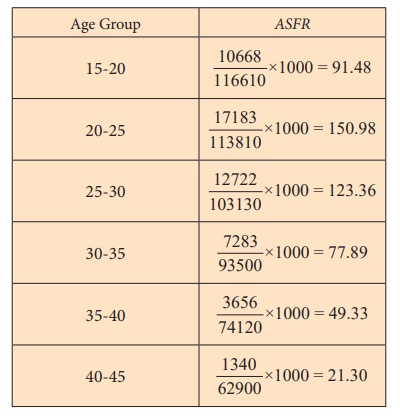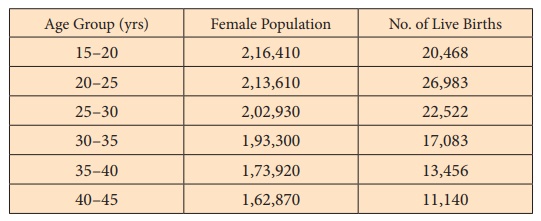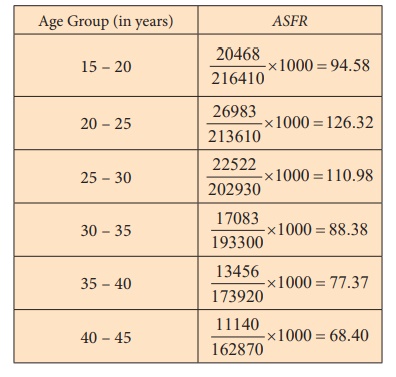Vital Statistics - Fertility and its Measurements | 12th Statistics : Chapter 8 : Vital Statistics and Official Statistics
Chapter: 12th Statistics : Chapter 8 : Vital Statistics and Official Statistics
Fertility and its Measurements
Fertility and its Measurements
Fertility refers to births occurring to the women who are at child bearing
age. A woman at child bearing age is defined as the age of the female
who can give birth to a child. In other words, it is the reproductive age of
woman.
Fertility rates are the quantitative characteristics, which are
used to measure the rate of growth of the population due to births
during a specified period, usually a year. The fertility rates are expressed per
thousand women who are at child bearing age.
As like mortality rates, there are several fertility rates. Among
them, the following are the basic fertility rates discussed here
(i) Crude Birth Rate
(ii) Specific Fertility Rate
(iii) General Fertility Rate
(i) Crude Birth Rate
Crude Birth Rate (CBR ) of a region or a community
relates the number of live births to size of the population of the
region or the community. This quantity can be computed using the formula

where
Bt denotes the number of live births occurred in a given
region/community during the period t, and
Pt denotes the population size of the given region/community during
the period t.
Example 8.10
The number of children born in a city during a period was 15,628
and the total population of the city in that period was 80,00,000. Find the
crude birth rate of the city.
Solution:
The Crude Birth Rate can be calculated using the formula
CBR = [ Bt / Pt ] ×1000
The CBR of the city is
CBR = [15628/8000000] ×1000
= 1.95 per thousand.
Example 8.11
People living in a town are grouped according to their age into
nine groups. Details about the number of live birts are also grouped according
to the age group of women. These information are presented in the following
table:

Calculate crude birth rate of the town.
Solution:
The total number of persons in the town during the specified
period can be calculated from the given information as
Pt = 1,89,000
and the total number of live births as
Bt = 4,130.
Hence, the Crude Birth Rate of the town is
CBR = [4130/189000] ×1000
= 21.85 per thousand.
CBR is the simplest fertility rate, which provides a comprehensive
idea about the population growth of any region/community. It is easy to compute
for any given region.
However, CBR does not take into account of the age and
gender distribution of the population or specifically the number of women at
the child bearing age. This is a crude measure, since it includes the sections
of the population who are not in the reproductive age group. It means that Pt
includes the sections of the population who are not exposed to the risk of
producing children, in particular, male and also the female beyond the
reproductive age. CBR also assumes that all the women at child bearing
age have the same reproductive capacity irrespective of their age, which is
totally unrealistic.
(ii) General Fertility Rate
General Fertility Rate (GFR) of a region or a community relates
the number of live births to the number of women in the reproductive
age.
i.e., GFR = Number of live births / Number of women at child bearing age ×1000

This quantity can be computed using the formula

Where
Pti denotes the number of women in the reproductive
age i years in the given region/ community during the period t,
i = a1 to a2.
In India, generally, a1 = 15 years and a2
= 49 years.
GFR overcomes the disadvantage of CBR considering only the
women population at the child bearing age group, since the denominator
in the above formula represents the entire women population at the reproductive
age group. GFR expresses the increase in the women population at the
child bearing age through live births.
However, GFR does not express the age composition of women
population at the reproductive age group. Hence, two different
regions/communities cannot be compared with respect to age of women using GFR.
Example 8.12
Women, at child bearing age, of a district are grouped into seven
age groups. The number of women lived during a calendar year in the district
and the number of live births recorded during the same period are as follows:

Calculate the general fertility rate of the district.
Solution:
The total number of women, at child bearing age in the district
during the study period can be calculated from the given information as

and the total number of live births as
Bt = 7,630.
Hence, the general fertility rate of the district is
GFR = [7630/163000] ×1000
= 46.81 per thousand.
(iii) Specific Fertility Rate (SFR)
It is a well known fact that fertility is affected by several
factors such as age, marriage, migration, region etc. But, both CBR
and GFR do not take into account of this fact. In this respect, Specific
Fertility Rate (SFR) is defined as

SFR = [ Number of live births to the women population in the
reproductive age groups of specific section in a given period / Total number of women in the reproductive
age groups of the specific section in the given period ] × 1000
SFR can be calculated separately for various age groups of females who
are at child bearing age such as 15-20, 20-25, and so on. The SFR
computed with respect to different reproductive age of women is known as the Age
Specific Fertility Rate (ASFR), which can be calculated using the
formula

where
Bt ( x , x + n) denotes the number of live births to the women in the
reproductive age group (x,x+n) during the period t in the
given region, and
Pt ( x , x + n) denotes the number of women in the reproductive age group
(x,x+n) during the period t in the given region.
Grouping of women with respect to their age is essential, since
capacity of women to give birth to child varies over the age of women. Thus, ASFR
enables to compare the fertility rates of two or more different regions with
respect to specific age groups. Moreover, ASFR can be considered as a
probability value.
Example 8.13
The female population, at reproductive age, of a country is
grouped into six age groups. The number of women in each group and the number
of live births given by them are given the following table.

Calculate the general fertility rate and the age specific
fertility rates of the country.
Solution:
Total number of women in the country at reproductive age during
the period of ‘t’ is

and the total number of live births of the country during the same
period is
Bt = 52,852
Therefore, the general fertility rate of the country is
GFR= [52852/564070]
×1000
= 93.69 per thousand.
The age specific fertility rates of the country can be calculated
for each age group using the formula

where
Bt ( x , x + n) denotes the number of live births to the women in the
reproductive age group (x,x+n) during the period t in the
given region, and
Pt ( x , x + n) denotes the number of women in the reproductive age group
(x,x+n) during the period t in the given region.
The ASFRs are calculated from the given information and are
presented in the following table:

It is can be observed, with respect to ASFRs, that the
women in the country falling in the age group of 20-25 years have given
relatively more live births. The women at the age of 40-45 years have
reproduced less number of live births.
Example 8.14
The following is the data regarding the size of female population
in a country at reproductive age and the live births during a period.

Calculate the general fertility rate and the age specific
fertility rates of the country.
Solution:
Size of the women population of the country at reproductive age
during the period ‘t’, is

and the total number of live births occurred during the same
period in the country is
Bt = 1,11,652.
Hence, the general fertility rate of the country during the period
is
GFR = [111652/1163040]
× 1000 = 96.00
The age specific fertility rate of the country during the same
period is calculated for each reproductive age group and the rates are
presented in the following table:

It can be observed, with respect to ASFR, that the women
population of the country falling in the age group of 20-25 years have given
relatively more live births. The women at the age of 40-45 years have
reproduced less number of live births.
Related Topics